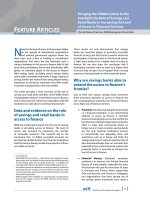The handbook of european structured financial products
Bạn đang xem bản rút gọn của tài liệu. Xem và tải ngay bản đầy đủ của tài liệu tại đây (13.11 MB, 801 trang )
The Handbook of
European
Structured
Financial Products
THE FRANK J. FABOZZI SERIES
Fixed Income Securities, Second Edition by Frank J. Fabozzi
Focus on Value: A Corporate and Investor Guide to Wealth Creation by James L.
Grant and James A. Abate
Handbook of Global Fixed Income Calculations by Dragomir Krgin
Managing a Corporate Bond Portfolio by Leland E. Crabbe and Frank J. Fabozzi
Real Options and Option-Embedded Securities by William T. Moore
Capital Budgeting: Theory and Practice by Pamela P. Peterson and Frank J. Fabozzi
The Exchange-Traded Funds Manual by Gary L. Gastineau
Professional Perspectives on Fixed Income Portfolio Management, Volume 3 edited
by Frank J. Fabozzi
Investing in Emerging Fixed Income Markets edited by Frank J. Fabozzi and
Efstathia Pilarinu
Handbook of Alternative Assets by Mark J. P. Anson
The Exchange-Traded Funds Manual by Gary L. Gastineau
The Global Money Markets by Frank J. Fabozzi, Steven V. Mann, and
Moorad Choudhry
The Handbook of Financial Instruments edited by Frank J. Fabozzi
Collateralized Debt Obligations: Structures and Analysis by Laurie S. Goodman
and Frank J. Fabozzi
Interest Rate, Term Structure, and Valuation Modeling edited by Frank J. Fabozzi
Investment Performance Measurement by Bruce J. Feibel
The Handbook of Equity Style Management edited by T. Daniel Coggin and
Frank J. Fabozzi
The Theory and Practice of Investment Management edited by Frank J. Fabozzi and
Harry M. Markowitz
Foundations of Economic Value Added: Second Edition by James L. Grant
Financial Management and Analysis: Second Edition by Frank J. Fabozzi and
Pamela P. Peterson
Measuring and Controlling Interest Rate and Credit Risk: Second Edition by
Frank J. Fabozzi, Steven V. Mann, and Moorad Choudhry
Professional Perspectives on Fixed Income Portfolio Management, Volume 4 edited
by Frank J. Fabozzi
The Handbook of European Fixed Income Securities edited by Frank J. Fabozzi
and Moorad Choudhry
The Handbook of
European
Structured
Financial Products
FRANK J. FABOZZI
MOORAD CHOUDHRY
EDITORS
John Wiley & Sons, Inc.
Copyright © 2004 by Frank J. Fabozzi. All rights reserved.
Chapters 15, 16, 17, 18, 22, 27, 32 copyright Moody’s Investors Service
Chapters 20, 21, 28, 33 copyright Standard & Poor’s Corporation
Published by John Wiley & Sons, Inc., Hoboken, New Jersey
Published simultaneously in Canada
No part of this publication may be reproduced, stored in a retrieval system, or transmitted in
any form or by any means, electronic, mechanical, photocopying, recording, scanning, or otherwise, except as permitted under Section 107 or 108 of the 1976 United States Copyright
Act, without either the prior written permission of the Publisher, or authorization through
payment of the appropriate per-copy fee to the Copyright Clearance Center, Inc., 222 Rosewood Drive, Danvers, MA 01923, 978-750-8400, fax 978-750-4470, or on the web at
www.copyright.com. Requests to the Publisher for permission should be addressed to the Permissions Department, John Wiley & Sons, Inc., 111 River Street, Hoboken, NJ 07030, 201748-6011, fax 201-748-6008, e-mail:
Limit of Liability/Disclaimer of Warranty: While the publisher and author have used their best
efforts in preparing this book, they make no representations or warranties with respect to the
accuracy or completeness of the contents of this book and specifically disclaim any implied
warranties of merchantability or fitness for a particular purpose. No warranty may be created
or extended by sales representatives or written sales materials. The advice and strategies contained herein may not be suitable for your situation. You should consult with a professional
where appropriate. Neither the publisher nor author shall be liable for any loss of profit or
any other commercial damages, including but not limited to special, incidental, consequential,
or other damages.
For general information on our other products and services, or technical support, please contact our Customer Care Department within the United States at 800-762-2974, outside the
United States at 317-572-3993, or fax 317-572-4002.
Wiley also publishes its books in a variety of electronic formats. Some content that appears in
print may not be available in electronic books.
For more information about Wiley, visit our Web site at www.wiley.com.
ISBN: 0-471-48415-6
Printed in the United States of America
10 9 8 7 6 5 4 3 2 1
Contents
About the Editors
Contributing Authors
xi
xiii
PART ONE
Structured Finance and Securitisation
1
CHAPTER 1
Introduction
Frank J. Fabozzi and Moorad Choudhry
3
CHAPTER 2
The Concept of Securitisation
Iain Barbour and Katie Hostalier
9
CHAPTER 3
Mechanics of Securitisation
Alexander Batchvarov, Jenna Collins, and William Davies
19
CHAPTER 4
Credit Derivatives Primer
Frank J. Fabozzi, Moorad Choudhry, Mark J.P. Anson, and Ren-Raw Chen
57
CHAPTER 5
True Sale versus Synthetics for MBS Transactions:
The Investor Perspective
Iain Barbour, Katie Hostalier, and Jennifer Thym
CHAPTER 6
A Framework for Evaluating a Cash (“True Sale”) versus
Synthetic Securitisation
Iain Barbour and Katie Hostalier
77
93
v
vi
Contents
CHAPTER 7
Assessing Subordinated Tranches in ABS Capital Structure
Alexander Batchvarov, Jenna Collins, and William Davies
117
CHAPTER 8
Key Consideration for Master Trust Structures
Alexander Batchvarov, Jenna Collins, and William Davies
131
CHAPTER 9
Trust and Agency Services in the Debt Capital Markets
Nick Procter and Edmond Leedham
143
PART TWO
Asset-Backed Securities
175
CHAPTER 10
European Credit Card ABS
Markus Niemeier
177
CHAPTER 11
European Auto and Consumer Loan ABS
Markus Niemeier
201
CHAPTER 12
European Public Sector Securitisations
Christopher Flanagan, Edward Reardon, and Doreen Tan
223
CHAPTER 13
Italian Lease-Backed Securities
Andrew Dennis
233
CHAPTER 14
European Mezzanine Loan Securitisations
Alexander Batchvarov, Jenna Collins, and William Davies
251
CHAPTER 15
Stock Securitisations
Carole Gintz
263
Contents
vii
CHAPTER 16
Rating Trade Receivables Transactions
Jean Dornhofer and Everett Rutan
273
CHAPTER 17
Moody’s Approach to Analysing Consumer Loan Securitisations
Nikoletta Knapcsek and Valentina Varola
291
CHAPTER 18
Nonperforming Loan Securitisation and Moody’s Rating Methodology
Antonio Serpico, Alex Cataldo, and Hernan Quipildor
305
PART THREE
Whole Business Securitisation
CHAPTER 19
Whole Business Securitisation
Anant Ramgarhia, Miray Muminoglu, and Oleg Pankratov
CHAPTER 20
Principles for Analysing Corporate Securitisations
Elena Folkerts-Landau, Pascal Bernous, Adele Archer,
Anthony Flintoff, and Apea Koranteng
CHAPTER 21
Balancing Cash Flow Predictability and Debt Capacity
in Corporate Securitisations
Blaise Ganguin, Apea Koranteng, Michael Wilkins, and Adele Archer
327
329
349
361
CHAPTER 22
Credit Analysis of Whole Business Securitisations
Benedicte Pfister
373
CHAPTER 23
Securitisation of UK Pubs
Andrew Dennis
389
viii
Contents
PART FOUR
Mortgage-Backed Securities
411
CHAPTER 24
European Residential Mortgage-Backed Securities
Phil Adams
413
CHAPTER 25
Italian Residential Mortgage-Backed Securities
Andrew Dennis
449
CHAPTER 26
European Commercial Mortgage-Backed Securities
Phil Adams
471
CHAPTER 27
Rating Approach to European CMBS
Benedicte Pfister
487
CHAPTER 28
Differentiating CMBS from Other Real Estate Securitised Financings
Elena Folkerts-Landau, Clayton Hunt, Ronan Fox, Adele Archer, and Ian Bell
513
CHAPTER 29
The German Pfandbrief and European Covered Bonds Market
Graham “Harry” Cross
523
PART FIVE
Collateralised Debt Obligations
551
CHAPTER 30
Structured Credit: Cash Flow and Synthetic CDOs
Oldrich Masek and Moorad Choudhry
553
CHAPTER 31
Single-Tranche Synthetic CDOs
Barnaby Martin, Alexander Batchvarov, and Atish Kakodkar
593
Contents
ix
CHAPTER 32
Rating Methodology for Collateralised Debt Obligations
Henry Charpentier and Hernan Quipildor
633
CHAPTER 33
CLOs and CBOs for Project Finance Debt: Rating Considerations
Arthur F. Simonson, William H Chew, and Henry Albulescu
653
CHAPTER 34
Independent Pricing of Synthetic CDOs
Farooq Jaffrey and David Jefferds
675
PART SIX
Credit-Linked Notes and Repacks
699
CHAPTER 35
Credit-Linked Notes
Moorad Choudhry and Frank J. Fabozzi
701
CHAPTER 36
Structured Credit Products and Repackaged Securities
Alessandro Cocco
715
INDEX
739
About the Editors
Frank J. Fabozzi, Ph.D., CFA, CPA is the Frederick Frank Adjunct Professor of Finance in the School of Management at Yale University. Prior to
joining the Yale faculty, he was a Visiting Professor of Finance in the
Sloan School at MIT. Professor Fabozzi is a Fellow of the International
Center for Finance at Yale University and the editor of the Journal of
Portfolio Management. He earned a doctorate in economics from the City
University of New York in 1972. In 1994 he received an honorary doctorate of Humane Letters from Nova Southeastern University and in 2002
was inducted into the Fixed Income Analysts Society’s Hall of Fame. He is
the honorary advisor to the Chinese Asset Securitization Web site.
Moorad Choudhry is Head of Treasury at KBC Financial Products (UK)
Limited in London. He previously worked as a government bond trader
and Treasury trader at ABN Amro Hoare Govett Limited and Hambros
Bank Limited, and in structured finance services at JPMorgan Chase
Bank. Moorad is a Fellow of the Centre for Mathematical Trading and
Finance, CASS Business School, and a Fellow of the Securities Institute.
He is author of The Bond and Money Markets: Strategy, Trading, Analysis, and a member of the Education Advisory Board, ISMA Centre, University of Reading.
xi
Contributing Authors
Phil Adams
Henry Albulescu
Mark J.P. Anson
Adele Archer
Iain Barbour
Alexander Batchvarov
Ian Bell
Pascal Bernous
Alex Cataldo
Henry Charpentier
Ren-Raw Chen
William H Chew
Moorad Choudhry
Alessandro Cocco
Jenna Collins
Graham “Harry” Cross
William Davies
Andrew Dennis
Jean Dornhofer
Frank J. Fabozzi
Christopher Flanagan
Anthony Flintoff
Elena Folkerts-Landau
Ronan Fox
Blaise Ganguin
Carole Gintz
Katie Hostalier
Clayton Hunt
Farooq Jaffrey
David Jefferds
Atish Kakodkar
Nikoletta Knapcsek
Apea Koranteng
Barclays Capital
Standard & Poor’s
CalPERS
Standard & Poor’s
Commerzbank Securities
Merrill Lynch
Standard & Poor’s
Standard & Poor’s
Moody’s Investors Service
Moody’s Investors Servive
Rutgers University (New Brunswick)
Standard & Poor’s
KBC Financial Products UK Limited
JPMorgan Chase
Merrill Lynch
YieldCurve.com
Merrill Lynch
UBS
Moody’s U.K.
Yale University
JPMorgan
Standard & Poor’s
Standard & Poor’s
Standard & Poor’s
Standard & Poor’s
Moody’s France
Commerzbank Securities
Standard & Poor’s
CreditTrade
CreditTrade
Merrill Lynch
Moody’s Italia
Standard & Poor’s
xiii
xiv
Edmond Leedham
Barnaby Martin
Oldrich Masek
Miray Muminoglu
Markus Niemeier
Oleg Pankratov
Benedicte Pfister
Nick Procter
Hernan Quipildor
Anant Ramgarhia
Edward Reardon
Everett Rutan
Antonio Serpico
Arthur F. Simonson
Doreen Tan
Jennifer Thym
Valentina Varola
Michael Wilkins
Contributing Authors
JPMorgan Chase Bank
Merrill Lynch
JPMorgan Securities Ltd.
JP Morgan
Barclays Capital
ABN AMRO
Moody’s Italy
JPMorgan Chase Bank
Moody’s Investors Service
ABN AMRO
JPMorgan
Moody’s U.S.
Moody’s Investors Service
Standard & Poor’s
Moody’s Italia
Standard & Poor’s
PART
One
Structured Finance and
Securitisation
CHAPTER
1
Introduction
Frank J. Fabozzi, Ph.D., CFA
Frederick Frank Adjunct Professor of Finance
School of Management
Yale University
Moorad Choudhry
Head of Treasury
KBC Financial Products UK Limited
ecuritisation has been one of the most exciting developments in fixed
income markets and illustrates perfectly the dynamic and flexible
nature of the market itself. First introduced in the United States domestic market in 1969, it arrived in Europe in the 1980s and has witnessed
dramatic growth right from inception. The application of securitisation
techniques gives rise to “structured finance” securities, which now
encompass a wide class of products, each of which deserves separate
treatment in its own right.
In simple terms, securitisation is a procedure by which financial
assets such as loans, consumer instalment contracts, leases, receivables,
and other relatively illiquid assets with common features that are held
on the balance sheet of a bank, financial institution, or other corporate
entity are used as collateral backing for a package of securities that are
issued to investors. The economic interest in the financial assets are
thereby transferred to investors via the securitisation process. At the
same time, illiquid financial assets are transformed into liquid securities
that trade, to a varying degree, in a secondary debt capital market.
While the actual process may be quite complex, involving a number of
third-parties such as lawyers, credit rating agencies, insurers, accoun-
S
3
4
STRUCTURED FINANCE AND SECURITISATION
tants, and trustee service providers, as a concept it is straightforward. It
has resulted in an enhanced range of corporate finance options, as well
as advanced the process of disintermediation by which the users of capital are brought closer together to the providers of capital.
The motivations behind securitisation are covered in detail in this
book, so we need not go into them here. Investors are attracted to such
engineered securities mainly because of their desirable investment and
maturity characteristics. However, the higher yield is associated with
investors bearing some degree of prepayment, early amortisation, credit,
and liquidity risk.
THE EUROPEAN STRUCTURED FINANCE MARKET
The first securitisation in the United States market used residential mortgage assets assets. The success of the securitisation process in the residential
mortgage markets as a funding source and the acceptance of the derived
securities by the investor base led to the application of this technology to
other assets, such as credit cards, home equity loans, automobile loans,
lease instalment contracts, and manufactured housing loans, to name a few
on the ever expanding list of securitisable assets. The first nonmortgage
asset-backed security, a computer lease-backed transaction, was issued in
March 1985. Later in that same year, the first auto loan-backed securities
were issued. Two years later, in 1987, the first credit-card backed security
was issued. Since then, the asset-backed market has expanded.
In Europe the first asset classes to be securitised were residential
mortgages in the United Kingdom in 1987. Since then, a wide range of
assets have been repackaged into structured finance securities, including:
■ Commercial mortgages
■ Corporate bank loans
■ Government assets such as lottery receipts and public sector housing
receipts
Credit card debt
Car-loan (“auto-loan”) receivables
Corporate assets such as nursing home and funeral home receivables
Equipment (such as photocopiers and other office equipment) lease
receivables
■ Consumer loans
■
■
■
■
The flexibility and applicability of the securitisation concept itself,
together with the inventiveness of investment bankers, means that virtually
5
Introduction
any asset is a candidate for transformation into structured finance securities. The type of asset that is being securitised determines what the issued
bond is called. Generally speaking, the structured financial product market
is composed of asset-backed securities (ABS), mortgage-backed securities
(MBS), collateralised debt obligations (CDO), and repackaged securities.
As we shall see later, the MBS market is subdivided further into residential
(RMBS) and commercial (CMBS) securities, while the CDO asset class also
comprises a number of different types too. As a rule of thumb, the nature of
the originating institution, as well as the asset class itself, determines what
the issued securities are called. Speaking generally, banks originate RMBS
and CMBS, while corporates issue ABS. Insurance companies and fund
managers issue CDOs.1
In Exhibit 1.1 issue volumes for the European market are shown,
along with issue volumes in all currencies shown as USD-equivalent.
Exhibit 1.2 shows the breakdown of issuance by original asset class.
Securitisation has been introduced in a number of countries across
Europe, both inside and outside the Eurozone.2 Exhibit 1.3 shows the
issuance breakdown by country, with the largest issuers shown to be the
United Kingdom and Italy.
A more recent development in the European market, again following the trend in the United States, was that of CDOs. The CDO market
is sometimes considered as distinctly separate from the ABS and MBS
EXHIBIT 1.1
European Issuance Volume, 1996–2003 YTD
Source: Securitization.Net, JPMorgan Chase Bank.
1
Like all rough rules of thumb, there are exceptions. Bank originators of corporate
loans would be issuing ABS, for example, and banks have also been large issuers of
CDOs. Government-sponsored issues are usually classed ABS.
2
During 2003 the newest countries in Europe to witness securitisation were Greece
and Poland, while during 2000 Portugal saw its first transaction.
6
STRUCTURED FINANCE AND SECURITISATION
market, but it follows the same principles used for the earlier products.
Its growth has been dramatic, given that the first CDOs were only issued
in Europe in 1998. Like the other products, it has been introduced in
several forms. The main distinction within CDOs has been about the
type of assets originated, whether loans (collateralized loan obligations
or CLOs) or bonds (collateralized bond obligations or CBOs), and the
motivation behind deal issuance, whether “arbitrage” or “balance sheet.”
These distinctions are discussed in detail later in this book.
Exhibit 1.4 shows CDO transaction issuance in the European market from 2000. Exhibit 1.5 shows the type of collateral originated during 2002.
EXHIBIT 1.2
Collateral Type During 2002
Source: Securitization.Net, JPMorgan Chase Bank.
EXHIBIT 1.3
Origination of Assets in Europe 2002
Source: Securitization.Net, JPMorgan Chase Bank.
7
Introduction
EXHIBIT 1.4
European CDO Issuance, 2002–2003
Source: Securitization.Net, JPMorgan Chase Bank.
EXHIBIT 1.5
CDO Collateral Type During 2002
Source: Securitization.Net, JPMorgan Chase Bank.
Part V of this book looks in detail at CDOs, including the newest
CDO type known as a synthetic CDO, which combines traditional securitisation techniques with credit derivatives.
ORGANISATION OF THIS BOOK
This book is organised into six parts. Part I introduces structured finance
products and the concept of securitisation. This includes chapters on the
mechanics of a securitisation transaction, as well as separate chapters that
analyse structured finance products from the point of view of investors
and originators. Included in Part I is a chapter on the various “agency”
8
STRUCTURED FINANCE AND SECURITISATION
services required, by investors, in a securitisation deal, and which are provided by specialist banks known as trust banks.
The following parts are split by products. Part II looks at ABS and
the various asset classes that have been originated as ABS. It includes
chapters on credit card ABS, consumer loan ABS, auto loan ABS, lease
securitisations, and mezzanine loan securitisations. There is also a chapter on public sector transactions, which have been dominated by issuance from the Italian government. Information about other types of
securitisation backed by trade receivables, corporate stock, and nonperforming loans, is also included.
A special type of ABS is whole business securitisations. (A specific
example of this type is U.K. pubs). This is covered in Part III.
Part IV focuses on residential and commercial MBS. Because of the
size of the Italian RMBS market, a chapter on that market is covered in
the book.
In Part V we look at CDOs, both cash and synthetic CDOs. This
includes a chapter on valuing CDOs. Because synthetic CDOs make extensive use of credit derivatives, we have included an introductory chapter on
these instruments in Part I.
Finally, Part VI looks at structured credit products in the form of
credit-linked rates and repackaged transactions. In all parts we have
also considered the analysis of structured financial products, primarily
credit analysis from the rating agency perspective.
CHAPTER
2
The Concept of Securitisation
Iain Barbour
Global Head of Securitisation
Commerzbank Securities
Katie Hostalier
Head of Structured Finance Research
Commerzbank Securities
ecuritisation has become a widely used term to describe many mechanisms through which risks are transferred between various parties.
The description encompasses the sale of risk assets in absolute form, as
well as the synthetic transfer of specific aspects of risk. This chapter
seeks to bring a definition to the word securitisation. We seek to define
the various contexts in which the word is used, the parties to such contracts, and their motivations. From this high-level background to the
market it is apparent that the world of securitisation is still being
defined—new asset classes and new mechanisms are being created, with
new counterparties coming to the market regularly.
S
WHAT IS SECURITISATION?
Securitisation is effectively a process through which loans, receivables,
and other assets are pooled. The related cash flows and economic values
are employed to support payments on related securities. These securities
are issued in the public and private markets by or on behalf of issuers,
who utilise securitisation to finance their business activities. These securities are generally referred to as asset-backed securities (ABS).
9
10
STRUCTURED FINANCE AND SECURITISATION
The investor’s risk is therefore linked to the assets which back the
securities he invests in. The primary source of interest payments and
repayment of principal of the ABS does not rely on the issuer’s general
revenues, but on the specific cash flows generated by the assets. The
investor’s credit analysis therefore focuses on a defined pool of assets.
Most securitisation transactions seek to isolate the financial assets
that support payment flows on the related ABS. Isolation ensures that
payments on the ABS are derived exclusively from the performance of a
specific, and often segregated, pool of financial assets.
The pool of assets securitised is frequently enhanced, either by
means of internal structural measures or with the help of outside parties, from a credit perspective. Liquidity facilities may provide some
credit enhancement, but usually provide a mechanism to streamline cash
flows on the transaction, ensuring a smoother flow of payments to
investors, especially where underlying payment flows on the securitised
assets are subject to some volatility.
This is why ABS are usually issued by special purpose vehicles
(SPVs) whose purpose is to hold a specific pool of assets and issue securities against these assets.
The basic concept of securitisation may be applied to virtually any
asset which has a reasonably ascertainable value, or that generates a
reasonably predictable future stream of revenue. As a result, securitisation has been extended beyond the typical asset classes (see Exhibit 2.1)
to less well-known asset classes, including insurance receivables, obligations of shippers to railways, obligations of purchasers to natural gas
producers, and future rights to entertainment royalty payments, among
many others.
The fundamentals of securitisation are relatively homogeneous,
being common to most transaction types. As a result, securitisation
structures and the roles and functions of key transaction participants are
similar wherever the securitisation concept is applied. This is the case
regardless of jurisdiction, despite different regulatory and legal environments. We discuss some generic securitisation transaction features and
compare true sale and synthetic securitisation structures later in this
document.
Securitisation may therefore be distinguished from other, more traditional forms of debt and equity financing, in which returns to investors are generally derived from the claims-paying ability or profitmaking potential of an ongoing business enterprise.
The ABS market can also be distinguished from the corporate debt
and equity markets because of the regular return of principal exhibited.
ABS require investors to assess the impact of alternative potential future









